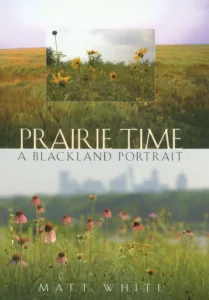In its most extensive prime, the Texas Blackland Prairie formed a twelve-million-acre grassy swath across the state from near San Antonio north to the Red River. Perhaps less than one tenth of one percent of this vast prairie remains—small patches tucked away here and there, once serving as hay meadows or sprouting from rock too stony to plow.
Matt White’s connections with both prairie plants and prairie people are evident in the stories of discovery and inspiration he tells as he tracks the ever dwindling parcels of tallgrass prairie in northeast Texas. In his search, he stumbles upon some unexpected fragments of virgin land, as well as some remarkable tales of both destruction and stewardship.
Helping us understand what a prairie is and how to appreciate its beauty and importance, White also increases our awareness of prairies, past and present, so that we might champion their survival in whatever small plots remain.



